
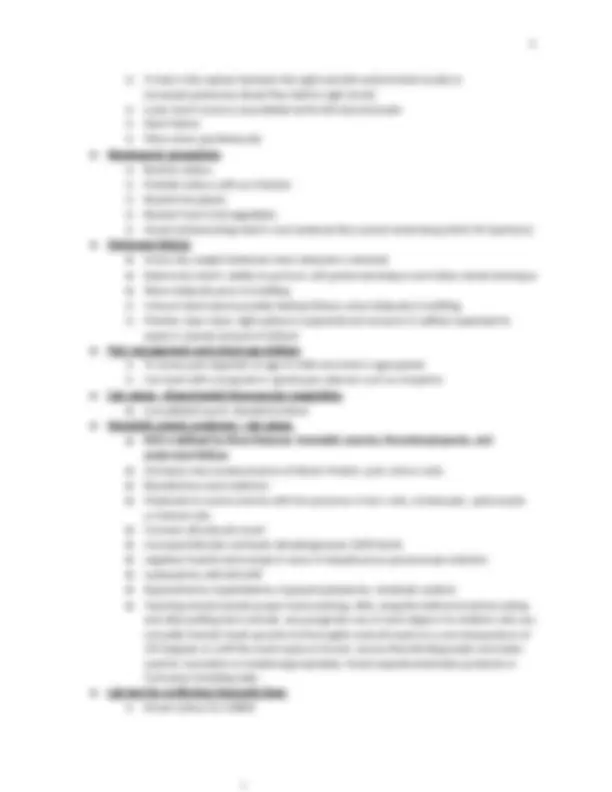
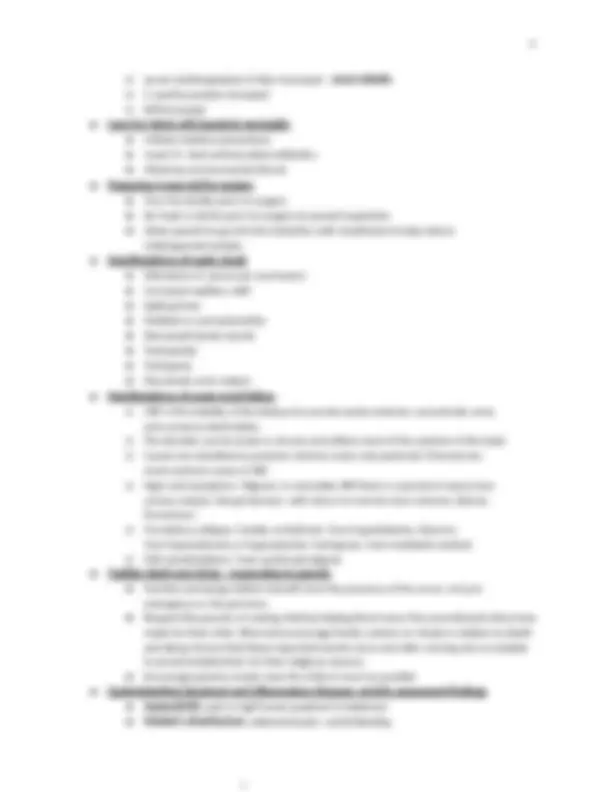
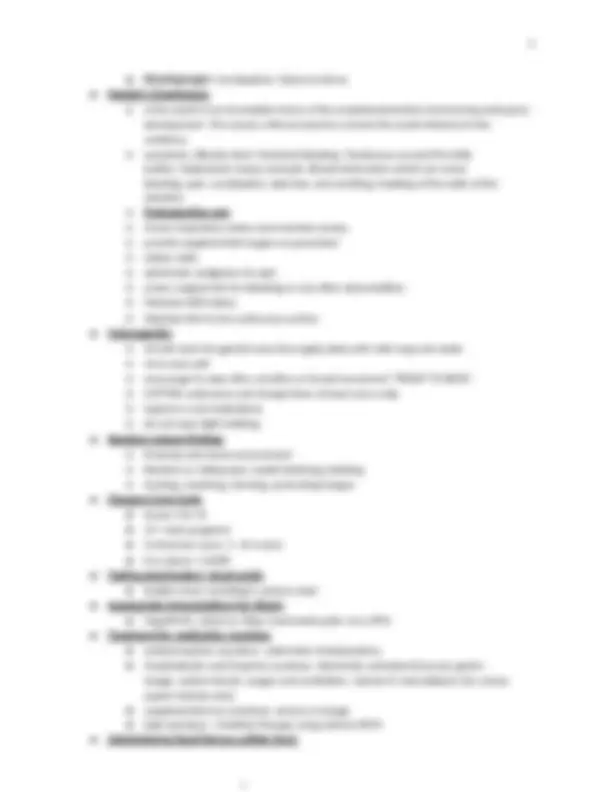
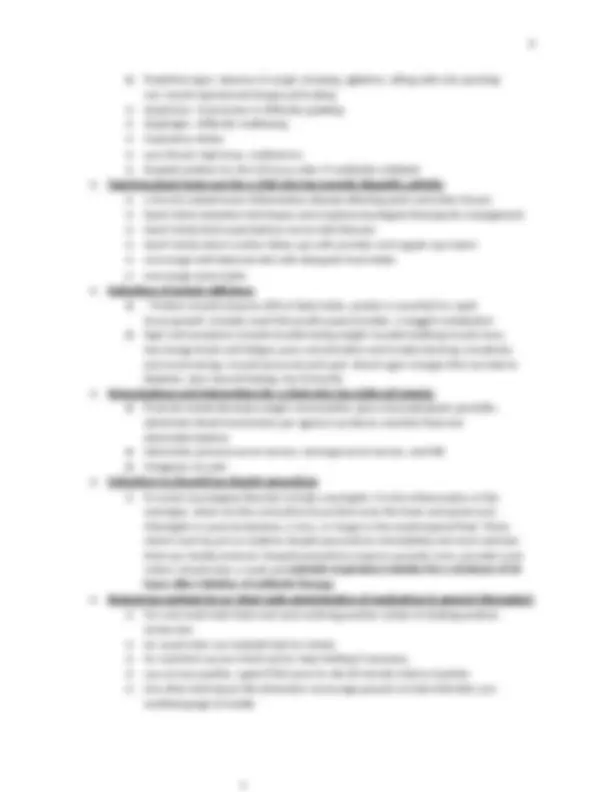
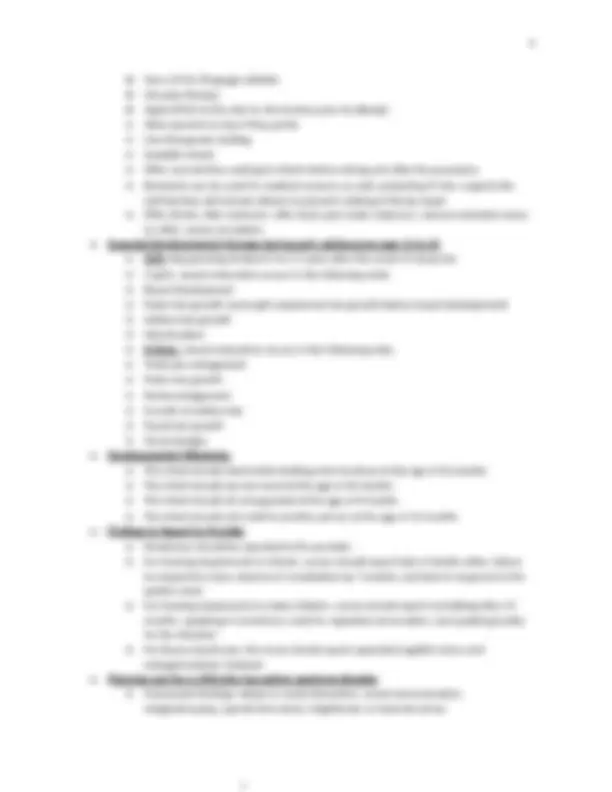
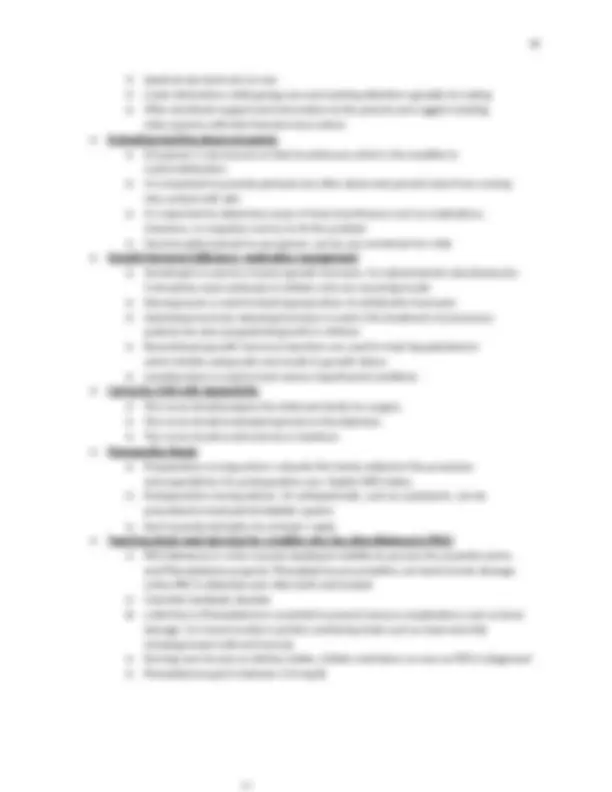

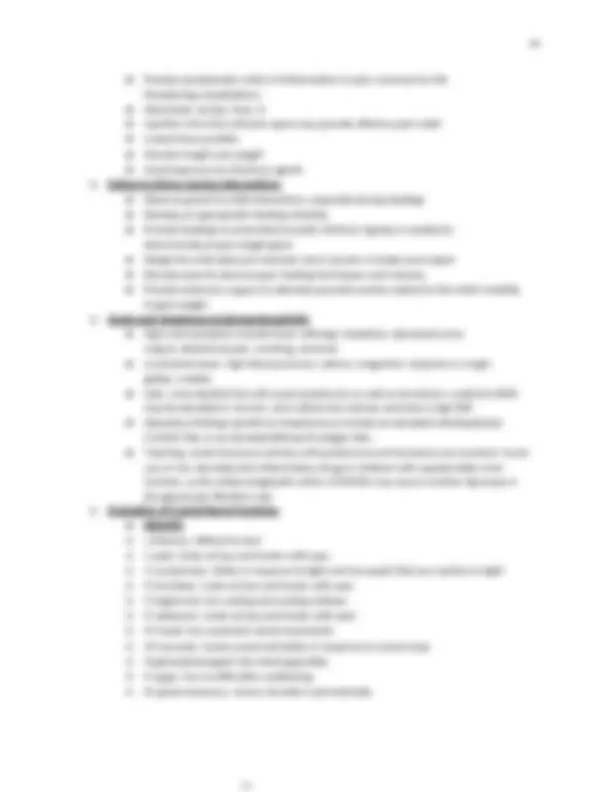
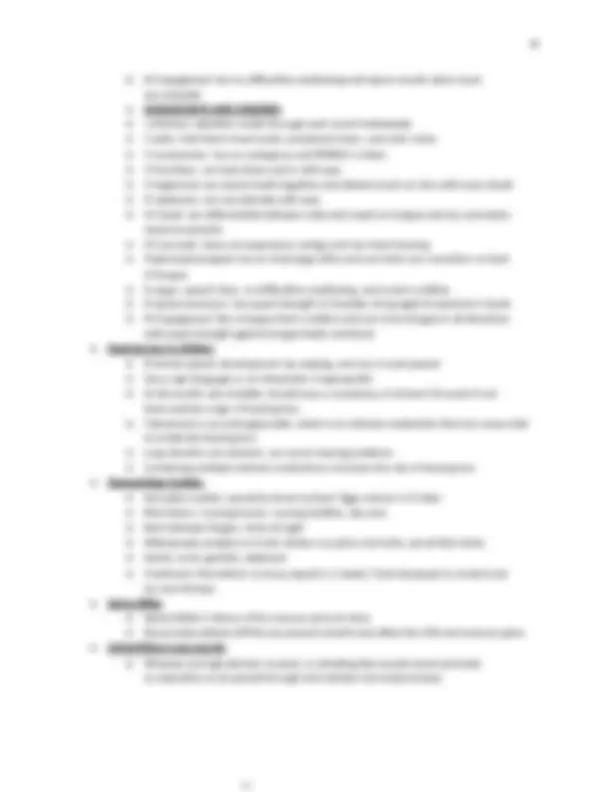
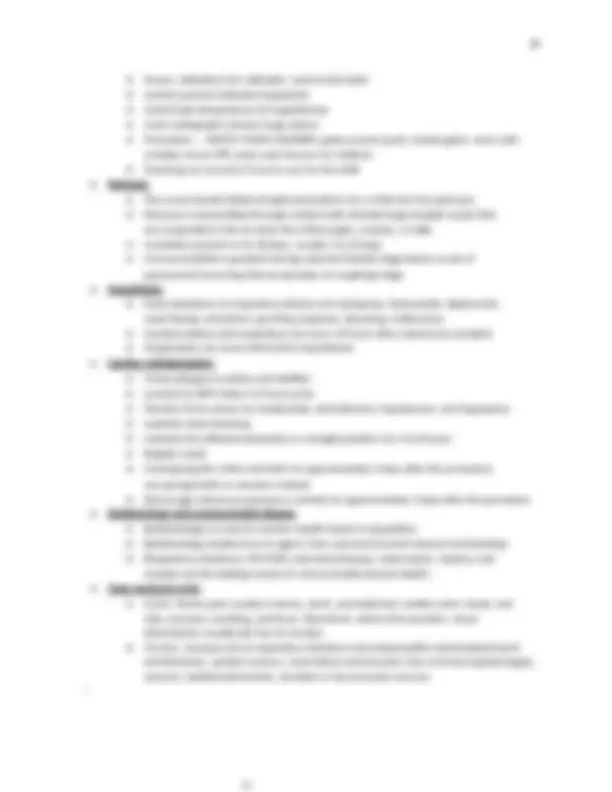


Study with the several resources on Docsity

Earn points by helping other students or get them with a premium plan


Prepare for your exams
Study with the several resources on Docsity

Earn points to download
Earn points by helping other students or get them with a premium plan
Community
Ask the community for help and clear up your study doubts
Discover the best universities in your country according to Docsity users
Free resources
Download our free guides on studying techniques, anxiety management strategies, and thesis advice from Docsity tutors
Pediatric CMS Review NotesPediatric CMS Review Notes
Typology: Study notes
1 / 18

This page cannot be seen from the preview
Don't miss anything!











CMS Review Topics o Monitoring for postoperative complications o Monitor for signs of infection o encourage mobilization as soon as possible o medicate for pain as needed o watch for compartment syndrome o compartment syndrome has increased pain, paresthesia (pins and needles), or numbness, pulselessness distal to fracture, inability to move digits, warm digits with skin taut and tight, shiny, pallor o Identifying priority child to assess o Prioritize systemic before local (life before Limb) o prioritize acute before chronic o prioritize actual problems before potential future problems o listen carefully to clients and own assume o recognize and respond to trends versus transient findings o recognize indications of medical emergencies and complications versus expected findings o Consider Maslow’s hierarchy of human needs o ABCDE- airway, breathing, circulation, disability, exposure o look for safety risk o least restrictive and least invasive interventions should be utilized as much as possible o Manifestations of nephrotic syndrome and lab findings o Hypoalbuminemia reduced serum protein and albumin o Hyperlipidemia elevated serum lipids o Hemoconcentration elevated hemoglobin, hematocrit, and platelets o Possible hyponatremia reduced sodium level o Glomerular filtration rate is normal or high o Tonic clonic seizures o Onset is without warning o Three parts: Tonic, clonic, and postictal o Hold head in lap if the client is on the floor o Turn the client to the side to decrease the risk of aspiration. o Loosen restrictive clothing o Document onset and duration of seizure and client findings/observations prior to during and following the seizure o Seizures – postictal period o Following a seizure, maintain the child in a side-lying position to prevent aspiration and to facilitate drainage of oral secretions o Check position of tongue o Perform neurologic checks o Maintain seizure precautions o Try to determine the possible trigger, such as fatigue or stress
o Child with heart failure o Heart failure occurs when the heart is unable to pump adequate blood to meet the metabolic and physical demands of the body o Impaired myocardial function: sweating, tachycardia, fatigue, pallor, cool extremities with weak pulses, hypotension, gallop rhythm, cardiomegaly PRIORITY FINDINGS o Pulmonary congestion: Tachypnea, dyspnea, Retractions, nasal flaring, grunting, wheezing, cyanosis cough, orthopnea (discomfort when breathing while laying flat), exercise intolerance o Systemic venous congestion: hepatomegaly, peripheral edema, ascites, neck vein distention, periorbital edema, weight gain o The metabolic rate is high because of poor cardiac function. Nurse should provide small, frequent meals to conserve energy- a feeding schedule should not be less than every 3 hours as this does not allow sufficient time for rest. Restrict play activities to bed to minimize energy expenditure. Weigh Daily and Maintain semi-fowlers position when in bed o Manifestations of Kawasaki Disease o Acute phase: High fever unresponsive to antipyretics(fever reducing drug) and antibiotics lasting 5 days to 2 weeks, irritability, red eyes without drainage, bright red, chapped lips, strawberry tongue, red oral mucous membranes, swelling of hands and feet with red palms and soles, non-blistering rash, bilateral joint pain, enlarged lymph nodes (cervical nodes on one side that are non tender), desquamation of the perineum, cervical lymphadenopathy, myocarditis, decreased left ventricular function, pericardial effusion, mitral regurgitation o Subacute phase: resolution of fever and gradual subsiding of other manifestations, irritability, peeling skin around the nails and on the palms and soles, temporary arthritis o The nurse should expect the child to be tachycardic with gallop rhythm. Long term effects include coronary artery aneurysms and myocardial infarctions o Blood Transfusion Reactions o Laryngeal edema is an indication of allergic reaction to a blood transfusion o Flank pain is caused by the breakdown of RBCs and is an indication of a hemolytic reaction to a blood transfusion o Distended neck veins are an indication of circulatory overload, which is a complication of blood transfusion o Muscle weakness is an indication of electrolyte disturbances, which is a complication of blood transfusion o Manifestations of Intussusception o Sudden episodic abdominal pain, screaming with drawing knees to chest during episodes of pain, sausage-shaped abdominal mass, stools mixed with blood and mucus that resemble the consistency of red currant jelly, vomiting, fever, tender, distended abdomen o Detected by ultrasound o Nursing care: stabilize the child prior to the procedure. IV fluids. NG tube. o Ventricular Septal Defect
o serum antistreptolysin O titer increased – most reliable o C reactive protein increased o ESR increased o Care for infant with bacterial meningitis o Initiate isolation precautions o Insert IV, start antimicrobial antibiotics o Minimize environmental stimuli o Preparing 4-year-old for surgery o Tour the facility prior to surgery o No food or drinks prior to surgery to prevent aspiration o Allow parents to go into the induction with anesthesia to help reduce child/parental anxiety o Manifestations of septic shock o Alterations in sensorium (confusion) o Increased capillary refill o Spiking fever o Mottled or cool extremities o Decreased bowel sounds o Tachycardia o Tachypnea o Decreased urine output o Manifestations of acute renal failure o ARF is the inability of the kidneys to excrete waste material, concentrate urine, and conserve electrolytes. o The disorder can be acute or chronic and affects most of the systems of the body o Causes are classified as prerenal, intrinsic renal, and postrenal. Prerenal are most common cause of ARF o Signs and symptoms: Oliguria: in reversible ARF there is a period of severe low urinary output, Abrupt diuresis: with return to normal urine volumes, Edema, Drowsiness o Circulatory collapse, Cardiac arrhythmia: from hyperkalemia, Seizures: from hyponatremia or hypocalcemia, Tachypnea: from metabolic acidosis o CNS manifestations: from continued oliguria o Toddler death and dying – responding to parents o Families and dying children benefit from the presence of the nurse, not just emergency or she performs. o Respect the parents of a dying child by helping them honor the commitments they have made for their child. Allow and encourage family customs or rituals in relation to death and dying. Ensure that these important events occur and alter nursing care as needed to accommodate them for their religious reasons. o Encourage parents remain near the child as much as possible o Gastrointestinal structural and inflammatory diseases: priority assessment findings o Appendicitis: pain in right lower quadrant of abdomen o Meckel’s diverticulum : abdominal pain, rectal bleeding
o Hirschsprung’s: Constipation, failure to thrive o Meckel’s Diverticulum o is the result of an incomplete fusion of the omphalomesenteric duct during embryonic development. This causes a fibrous band to connect the small intestine to the umbilicus o symptoms: Bloody stool, Intestinal bleeding, Tenderness around the belly button, Abdominal cramps and pain, Bowel obstruction which can cause bloating, pain, constipation, diarrhea, and vomiting, Swelling of the walls of the intestine o Postoperative care o Assess respiratory status and maintain airway o provide supplemental oxygen as prescribed o obtain vitals o administer analgesics for pain o assess surgical site for bleeding or any other abnormalities o Maintain NPO status o Maintain NG to low continuous suction o Vulvovaginitis o should wash the genital area thoroughly daily with mild soap and water. o rinse area well o encourage to wipe after urination or bowel movement FRONT TO BACK o COTTON underwear and change them at least once a day o topical or oral medications o do not wear tight clothing o Newborn seizure findings o Promote safe home environment o Random or rolling eyes, eyelid twitching, blinking o Sucking, smacking, chewing, protruding tongue o Glasgow Coma Scale o Scores 3 to 15 o 15 = best prognosis o 3 minimum score, 3 - 8 is coma o 8 or above = GOOD o Testing preschoolers’ visual acuity o Snellen chart, tumbling E, picture chart o Appropriate immunizations for infants o hepatitis B, rotavirus, Dtap, inactivated polio virus (IPV) o Treatment for medication overdose o acetaminophen overdose - administer Acetylcysteine o Acetylsalicylic acid (Aspirin) overdose- Administer activated charcoal, gastric lavage, sodium bicarb, oxygen and ventilation, vitamin K, hemodialysis (for severe aspirin toxicity only) o supplemental iron overdose- emesis or lavage o lead overdose - chelation therapy using calcium EDTA o Administering liquid ferrous sulfate (iron)
o Chlamydia is the most common bacterial STI o Gonorrhea is the oldest communicable sti in the US o Teaching about increased intracranial pressure o Increased ICP occurs with severe injuries o Infants: bulging fontanels, separation of cranial sutures, irritability, restlessness, increased sleeping, high pitched cry, poor feeding, setting sun sign, and distended scalp veins o Children: nausea, headache, forceful vomiting, blurred vision, increased sleeping, inability to follow simple commands, decline in school performance, seizures o late signs: alterations in pupillary response, posturing (flexion/extension), Brady cardia, decreased motor response to painful stimuli, Cheyne-Stokes respirations, Optic disc swelling, decreased consciousness, and coma o Flexion is a sign of severe dysfunction of cerebral cortex o extension is a sign of severe dysfunction at level of midbrain o Planning care for infant who has bronchiolitis o Manifestations are dry, hacky cough o Signs and symptoms: Rhinorrhea, intermittent fever, coughing, sneezing, wheezing, possible ear or eye infection, tachypnea and retractions, copious sections, listlessness, apnea spells, cyanosis. o Give supplemental oxygen to maintain equal or greater than 90%. o Nasopharyngeal and nasal suctioning as needed. o Encourage breastfeeding. o Expected findings of severe dehydration o Mild: behavior, mucous membranes, anterior fontanel, pulse, and BP within normal limits. Cap refill greater than 2 seconds. Possible slight thirst. o Moderate dehydration: sunken fontanelles, tachycardia, normal blood pressure, alert but listless. o Severe dehydration: alert to comatose, sunken fontanels, tachycardia progressing to Bradycardia, tenting turgor, blood pressure normal, progressing to hypotension o Weight loss greater than or equal to 10%, capillary refill greater than 4 seconds, tented skin, and very dry mucous membranes, hyperpnea o Care for a child who has oral ulcers o apply local anesthetics o use agents such as mouthwashes and lozenges that are effective against fungal and bacterial infections o avoid viscous lidocaine, hydrogen peroxide, milk of magnesia and lemon glycerin swabs o Nursing actions for a child who has epiglottitis o Medical emergency: protect airway avoid a throat culture, prepare for intubation, provide humidified O2, monitor continuous O2, administer racemic epi, corticosteroids, and IV fluids, administer antibiotic o Do not under any circumstances attempt to visualize the throat, reflex Larry and Joe spasm may occur, precipitating immediate airway occlusion.
o Predictive signs: absence of cough, drooling, agitation, sitting with chin pointing out, mouth opened and tongue protruding o dysphonia - hoarseness or difficulty speaking o dysphagia - difficulty swallowing o inspiratory stridor o sore throat, high fever, restlessness o Droplet isolation for first 24 hours after IV antibiotics initiated o Teaching about home care for a child who has juvenile idiopathic arthritis o a chronic autoimmune inflammatory disease affecting joints and other tissues o teach client relaxation techniques and nonpharmacological therapeutic management o teach family that exacerbations worse with illnesses o teach family about routine follow ups with provider and regular eye exams o encourage well balanced diet with adequate food intake o encourage warm baths o Indications of protein deficiency o * Protein should comprise 20% of daily totals, protein is essential for rapid tissue growth, includes meat fish poultry peanut butter, a sluggish metabolism o Signs and symptoms include trouble losing weight, trouble building muscle mass, low energy levels and fatigue, poor concentration and trouble learning, moodiness and mood swings, muscle bone and joint pain, blood sugar changes that can lead to diabetes, slow wound healing, low immunity o Immunizations and interventions for a client who has sickle cell anemia o Promote rested decrease oxygen consumption, give oral prophylactic penicillin, administer blood transfusions per agency's protocol, maintain fluid and electrolyte balance o Administer pneumococcal vaccine, meningococcal vaccine, and HIB o Analgesics for pain o Indications to discontinue droplet precautions o An acute neurological disorder includes meningitis. It is the inflammation of the meninges, which are the connective tissue that cover the brain and spinal cord. Meningitis is cause by bacteria, a virus, or fungus in the cerebrospinal fluid. These clients must be put on isolation droplet precautions immediately and must maintain them per facility protocol. Droplet precautions require a private room, providers and visitors should wear a mask and maintain respiratory isolation for a minimum of 24 hours after initiation of antibiotic therapy o Restraining methods for an infant (safe administration of medications & general information) o For oral meds hold infant and semi reclining position similar to feeding position, stroke chin. o for nasal meds use football hold for infants o for injections secure infant ask for help holding if necessary o use sucrose pacifier, apply EMLA prior to site 60 minutes before injection o Use other techniques like distraction encourage parents to hold child after you smallest gauge of needle
o Speak at eye level one on one o Lower distractions while giving care and wanting attention specially for eating o Offer emotional support and information to the parents and suggest meeting other parents with kids that also have autism o Evaluating teaching about encopresis o Encopresis is also known as fetal incontinence which is the inability to control defecation o It is important to provide perineal care after stools and prevent stool from coming into contact with skin. o It’s important to determine cause of fecal incontinence such as medications, infections, or impaction and try to fix the problem o Must be potty trained for encopresis, can be very emotional for child o Growth Hormone Deficiency- medication management o Somatropin is used as a human growth hormone, it is administered subcutaneously. It should be used cautiously in children who are receiving insulin o Desmopressin is used to treat hyposecretion of antidiuretic hormones o luteinizing hormone releasing hormone is used in the treatment of precocious puberty too slow prepubertal growth in children o Recombinant growth hormone injections are used to treat hypopituitarism which inhibits cell growth and results in growth failure o Levothyroxine is used to treat various hypothyroid conditions o Caring for child with Appendicitis o The nurse should prepare the child and family for surgery. o The nurse should avoid placing heat on the abdomen. o The nurse should avoid enemas or laxatives. o Hypospadias Repair o Preoperative nursing actions: educate the family related to the procedure and expectations for postoperative care. Explain NPO status. o Postoperative nursing actions: An antispasmodic, such as oxybutynin, can be prescribed to treat painful bladder spasms. o Don't provide tub baths for at least 1 week. o Teaching about meal planning for a toddler who has phenylketonuria (PKU) o PKU deficiency in a liver enzyme leading to inability to process the essential amino acid Phenylalanine properly. Phenylalanine accumulation can lead to brain damage unless PKU is detected soon after birth and treated o Inherited metabolic disorder o a diet low in Phenylalanine is essential to prevent serious complications such as brain damage. it is found mostly in protein containing foods such as meat and milk including breast milk and formula o Nursing care focuses on dietary intake, initiate restrictions as soon as PKU is diagnosed o Phenylalanine goal is between 2-8 mg/dL
o watch for signs of PKU: cognitive impairment, hyperactivity, erratic behavior, bizarre behavior, fright reactions, headbanging, arm biting, disorientation, spasticity or catatonic like positions, seizures o Teaching about home interventions for night terrors ages 3 to 6 o keep consistent bedtime routine o use night-light in the room o provide child with favorite toy o leave drink of water by bed o reassure preschoolers who are frightened, but avoid allowing them to sleep in parent's bed o Priority finding for an infant who is receiving furosemide o Increased urine output is directly observed in a patient receiving Furosemide. In infants, the priority finding would be an increased urine output as well. Input and output for patients receiving Furosemide should be strictly monitored, dehydration can happen if fluid losses become uncontrolled, most especially in infants. o Contraindications for receiving the MMR vaccine o Do not administer live virus vaccines, such as varicella or MMR, to a child who is severely immunocompromised. o Pregnancy, allergy to gelatin and neomycin, history of thrombocytopenia or thrombocytopenia purpura, Immunosuppression (with HIV infection or medication administration), recent blood transfusion with blood or immunoglobulins o Priority finding for an adolescent who has type one diabetes mellitus o Blood glucose alternations is a priority o Acceptable HbA1c level for diabetic children is 6.5% to 8% (target goal =7%) o Expected range is 4% to 5.9% for nondiabetic o 8 hour fasting blood glucose of 126 mg/dL or more is a diagnostic level for diabetes o Teaching: Tell the child to check the accuracy of the strips with the control solution provided. o Teaching: Advise the child to keep a record of the self-monitored blood glucose that includes time, date, serum glucose level, insulin dose, food intake, and other events that can alter glucose metabolism, such as activity level or illness. o Teach: the manifestations of hypoglycemia (shakiness, diaphoresis, anxiety, nervousness, chills, HA, confusion, labile, difficulty focusing, hunger, dizziness, pallor, palpations). Normal or shallow respirations during hypoglycemia. o Teach: the manifestations of hyperglycemia (lethargy, confusion, thirst, nausea, vomiting, abdominal pain, signs of dehydration, rapid respirations, fruity breath). Rapid, deep respirations with acetone/fruity odor due to ketones (Kussmaul respirations) during hyperglycemia and diabetic ketoacidosis. o Scoliosis Assessment findings o should expect to find asymmetry in scapula, ribs, flanks, shoulders, and hips when a child has scoliosis. o Clothing may fit improperly due to the curved spine and/or one leg being shorter than the other.
o SPREAD: Direct contact o Droplet (airborne), Contaminated objects o INCUBATION: 2 to 3 weeks, usually 14 to 16 days o COMMUNICABILITY: 1 day before lesions appear until all lesions have formed crusts o Evaluating the understanding of cast care o Assess neurovascular status of extremity o Elevate affected limb above level of heart during 1st 24 to 48 hours to prevent swelling o Apply ice for the first 24 hours to decrease swelling o Turn and position every 2 hours o Do not use heat lamps or warm dryers o Findings to report for toddler who has full thickness burns o damage to epidermis and dermis and maybe SubQ o Nerve endings, hair follicles and sweat glands are destroyed o red, black, white, dry, leathery, no blanching o no pain, heals weeks- months, scarring o grafting required (in children graft options are leg/buttock skin, fish, pig, o biggest concerns after acute phase for burns is contractions, cosmetic issues after o Manifestations of Hodgkin's lymphoma o Enlarged lymph nodes, can have fever, night sweats, weight loss, fatigue o o Indications of child abuse o assess for unusual bruising on abdomen, back, and buttocks o bruises at different stages of healing equals ongoing beatings o Glove or stocking like on hands and feet, forced immersion into boiling substances o Fractures with rare features for example a forearm spiral fracture or multiple fractures o photograph all visible injuries o use open ended questions that require a direct response o Rating a child's post operative pain level o FLACC - two months to seven years Assess behaviors of the child o FACES – Three years older using diagram of six faces o OUCHER – 3 to 13 years pain on a scale of zero to 5 using six photographs o NUMERIC SCALE – five years and older rate pain on scale of 1 to 10 o NON-COMMUNICATING - 3 to 18 years behaviors observed for 10 minutes and categorizes score used from 0- o Cardiovascular disorders withholding digoxin o contraindicated in, hypersensitivity, uncontrolled ventricular arrhythmias, AV block in absence of pacemaker, idiopathic hypertrophic subaortic stenosis, constructive pericarditis, known alcohol intolerance (elixir only), Withhold when infants pulse is less than 90 beats per minute and when children's pulse rate is less than 70 beats per minute, monitor for toxicity as evidenced by Brady cardia, dysrhythmias, nausea vomiting, and anorexia o teaching about Prednisone
o Provide symptomatic relief of inflammation in pain, reserved for life threatening complications o Administer via Eye, Oral, IV o Injection into intra articular space may provide effective pain relief o Lowest dose possible o Monitor height and weight o Avoid exposure to infectious agents o Failure to thrive nursing interventions o Observe parent to child interactions, especially during feedings o Develop an appropriate feeding schedule o Provide feedings as prescribed (usually 120 kCal /kg/day is needed to demonstrate proper weight gain) o Weigh the child daily and maintain strict records of intake and output o Educate parents about proper feeding techniques and volumes o Provide extensive support to alleviate parental anxiety related to the child's inability to gain weight o Acute post streptococcal glomerulonephritis o Signs and symptoms include fever, lethargy, headache, decreased urine output, abdominal pain, vomiting, anorexia o on physical exam, high blood pressure, edema, congestion, dyspnea or cough, gallop, crackles o Labs: urine dipstick test will reveal proteinuria as well as hematuria. creatinine BUN may be elevated or normal. urine will be tea colored, and have a high ESR o laboratory findings specific to streptococcus include an elevated antistreptolysin O (ASO) Titer in an elevated DNAase B antigen titer. o Teaching: avoid strenuous activity until proteinuria and hematuria are resolved. Avoid use of non-steroidal anti-inflammatory drugs in children with questionable renal function, as the antiprostaglandin action of NSAIDs may cause a further decrease in the glomerular filtration rate o Evaluation of Cranial Nerve Functions o INFANTS o I olfactory: Difficult to test o II optic: looks at face and tracks with eyes o III oculomotor: blinks in response to light and has pupils that are reactive to light o IV trochlear: Looks at face and tracks with eyes o V trigeminal: has rooting and sucking reflexes o VI abducens: Looks at face and tracks with eyes o VII facial: has symmetric facial movements o VIII acoustic: tracks sound and blinks in response to a loud noise o IX glossopharyngeal: Has intact gag reflex o X vagus: has no difficulties swallowing o XI spinal accessory: moves shoulders symmetrically
o Crackles are high-pitched, short and noncontinuous sounds heard usually at the end of inspiration. They occur when air expands deflated alveoli or when the passage of air through small airways is disrupted. o Pleural friction rub is a loud, rough, grating sounds and can be heard during inspiration or expiration. It occurs when the pleurae are inflamed, and the surfaces rub together. o Rhonchi are low-pitched continuous sounds that have a snore-like quality and are usually louder during expiration. It occurs when the larger airways are obstructed. o Celiac Disease o Providing child and family education is the key nursing role in managing children with celiac disease. The child must adhere to a strict gluten-free diet for his or her entire life. This is often very challenging, because gluten is found in most wheat products, rye, barley, and possibly oats. Encourage the parents and child to maintain this gluten- free diet. o Wilms Tumor o Wilms' tumor (nephroblastoma) is a malignancy that occurs in the kidneys or abdomen. The tumor is usually unilateral, with 10% of cases affecting both kidneys. Diagnosis typically occurs before age 5, with most cases diagnosed between 2 and 3 years of age. metastasis is rare. o If Wilms' tumor is suspected, DO NOT palpate the abdomen. o Use extreme caution when handling or bathing the client to prevent trauma to the tumor site. o Signs and symptoms: firm nontender abdominal swelling or mass, fatigue malaise, weight loss, fever, hematuria, HTN, Painless palpable abdominal mass o Cushing’s Disease manifestations o hypercortisolism o Weakness, fatigue, sleep disturbances, back and joint pain o Brain Tumor o Brain herniation is a downward shift of brain tissue o Care is determined by extent of trauma to brain o Monitor for clear fluid which is cerebral spinal fluid coming from ears or nose o infratentorial (cerebellum/brain stem -posterior) - Supratentorial (mid structure brain) o VP shunt/ seizure meds potential o Acute Lymphocyte Leukemia o Most common in kids o Various factors influence the prognosis for children, but 5-year survival rate is approximately 85% (age at diagnosis, gender, cell type involved); less than 50% of adults can be cured. o Assessment findings: Bruising which can become excessive, Bone ache, Petechiae, tiny red spots or lines that appear on the skin due to low platelet count, Infections which are periodic, Fever, Pallor, Shortness of breath, Weight loss, A headache, vomiting, enlarged lymph nodes, increased size of liver and spleen o Physical examination: look for bruising and other symptoms.
o Complete blood count (CBC): To check for the presence of a large number of immature lymphocytes that interfere with the production of new red blood cells, white blood cells, and platelets. o Bone marrow biopsy: This test takes a bone sample to examine for the presence of leukemic lymphoblasts microscopically. o Testicular Cancer o Testicular cancer is a disease in which malignant (cancer) cells form in the tissues of one or both testicles. o There are several types of testicular tumors. Seminomas, Non-seminomas (embryonal cell carcinoma, teratomas, and choriocarcinoma), Stromal cell tumors o Signs and symptoms of testicular cancer include a painless lump in the testicles or early puberty. a painless lump in the testicle (the most common sign), feeling of weight in the scrotum, swelling of the testicle (with or without pain), pain or a dull ache in the testicle, scrotum, or groin o The exact cause is not known, but some risk factors include undescended testes and congenital abnormalities of the testes. o Prevention: self-examination regularly o Tests that examine the testicles are used to help diagnose non-germ cell testicular cancer. Treatment options include radiotherapy, chemotherapy, and surgery. o Muscular dystrophy o Largest group of inherited muscular diseases in children o Lead to progressive degeneration of skeletal muscles o Gradual degeneration of muscle fibers, progressive weakness, and wasting of skeletal muscles o Pseudo hypertrophic Muscular Dystrophy (Duchenne Disease) o Most severe and most common MD in childhood o Inherited as a sex-linked recessive trait, only occurs in boys o Symptoms usually apparent by 3 years of age o Life expectancy reaches into early adulthood o Primary goal - -maintain function in unaffected muscles as long as possible o Encourage low-calorie, high-protein diet to avoid excessive weight gain o Prevent constipation w/ fiber, fluids, stool softener if needed o Congenital hip dislocation o Congenital dislocation or subluxation of the hip (congenital acetabular dysplasia) is a complete or partial displacement of the femoral head out of the acetabulum o The physical signs essential for diagnosis are age related. In newborns the tests for instability are the most sensitive. After the neonatal period, and until the age of walking, tightness of the adductor muscles is the most reliable sign. o Early diagnosis is vital for successful treatment of this partially genetically determined condition. Various therapeutic measures, ranging from abduction splinting to open reduction and osteotomy, may be required. o Submersion injuries o Emergency priority - Administer oxygen, use a calm approach, Monitor vital signs.